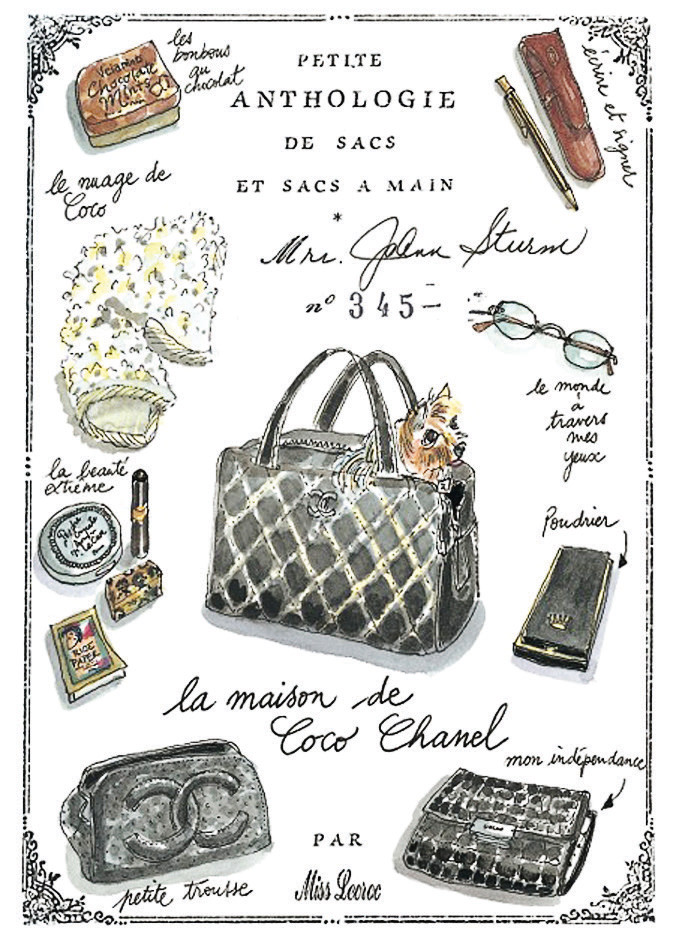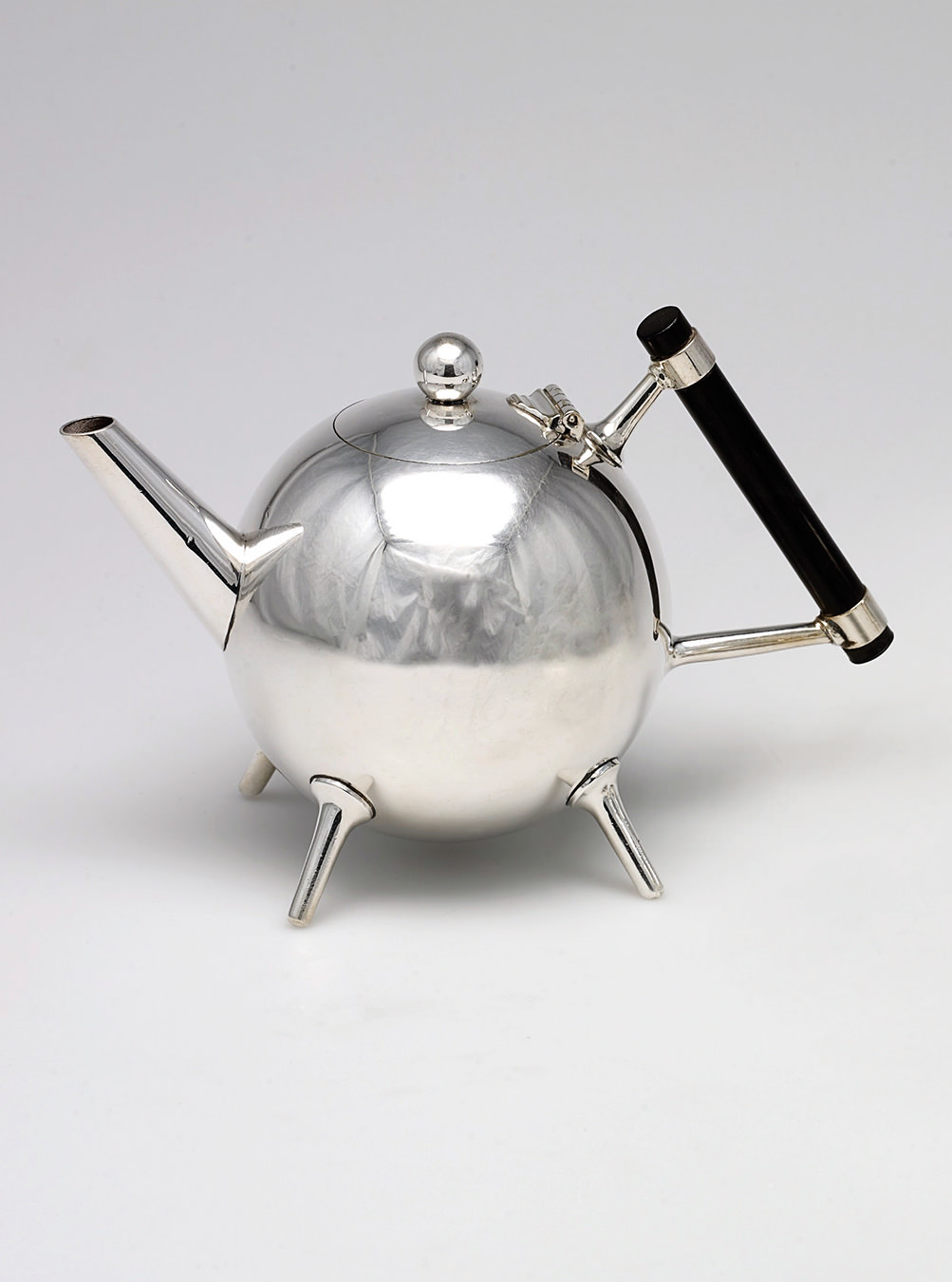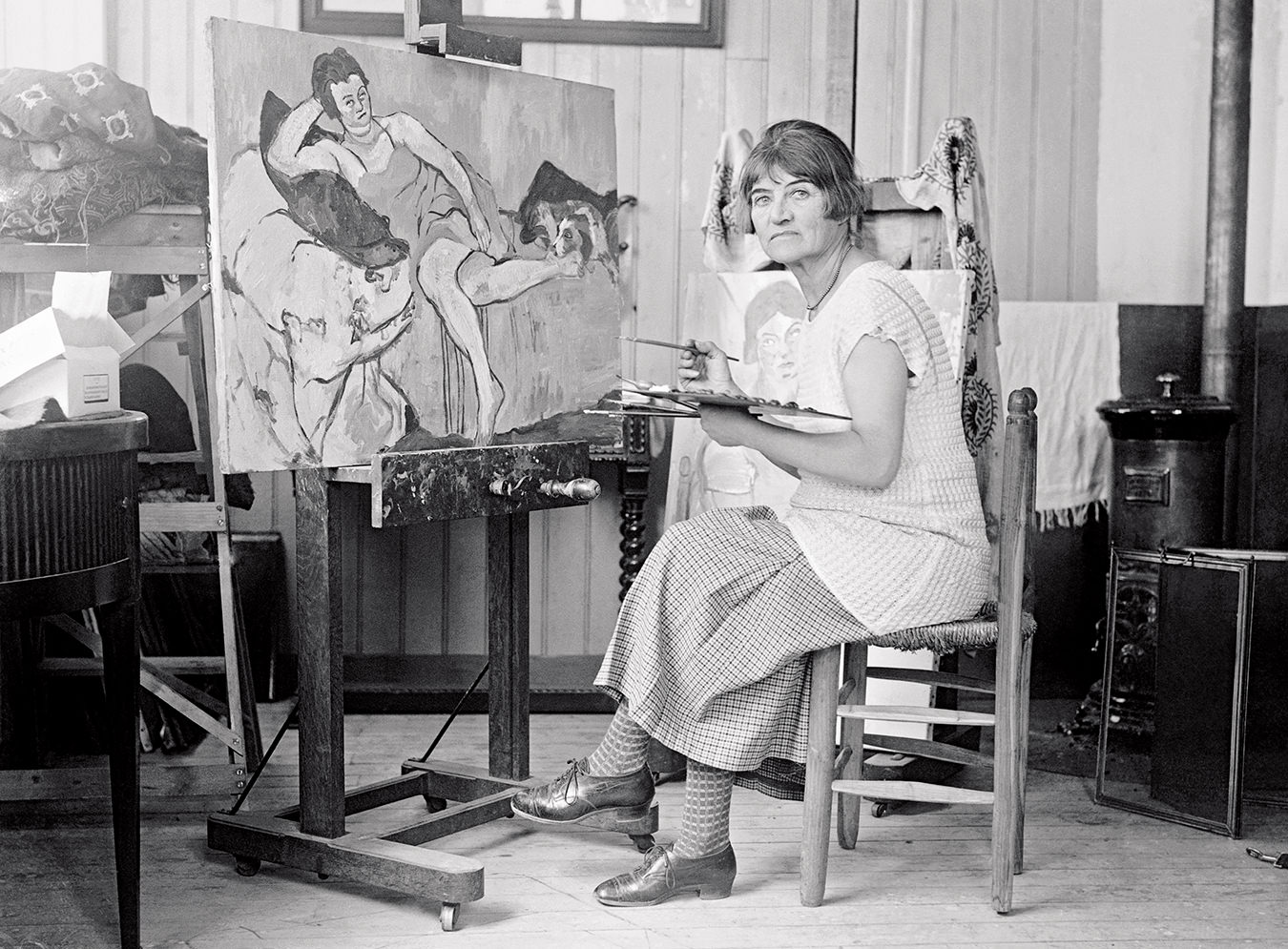-
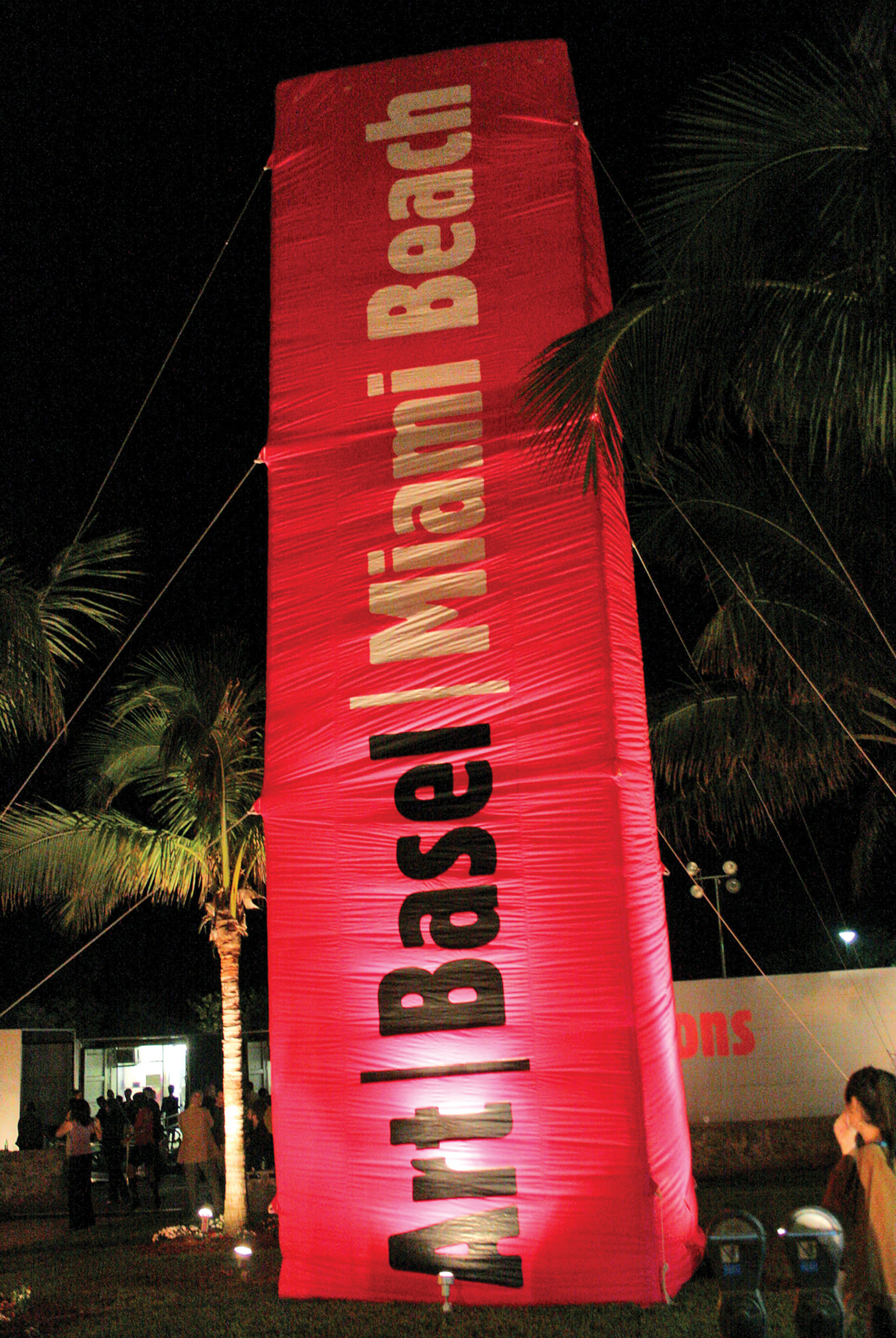
Welcome to the Fair.
-
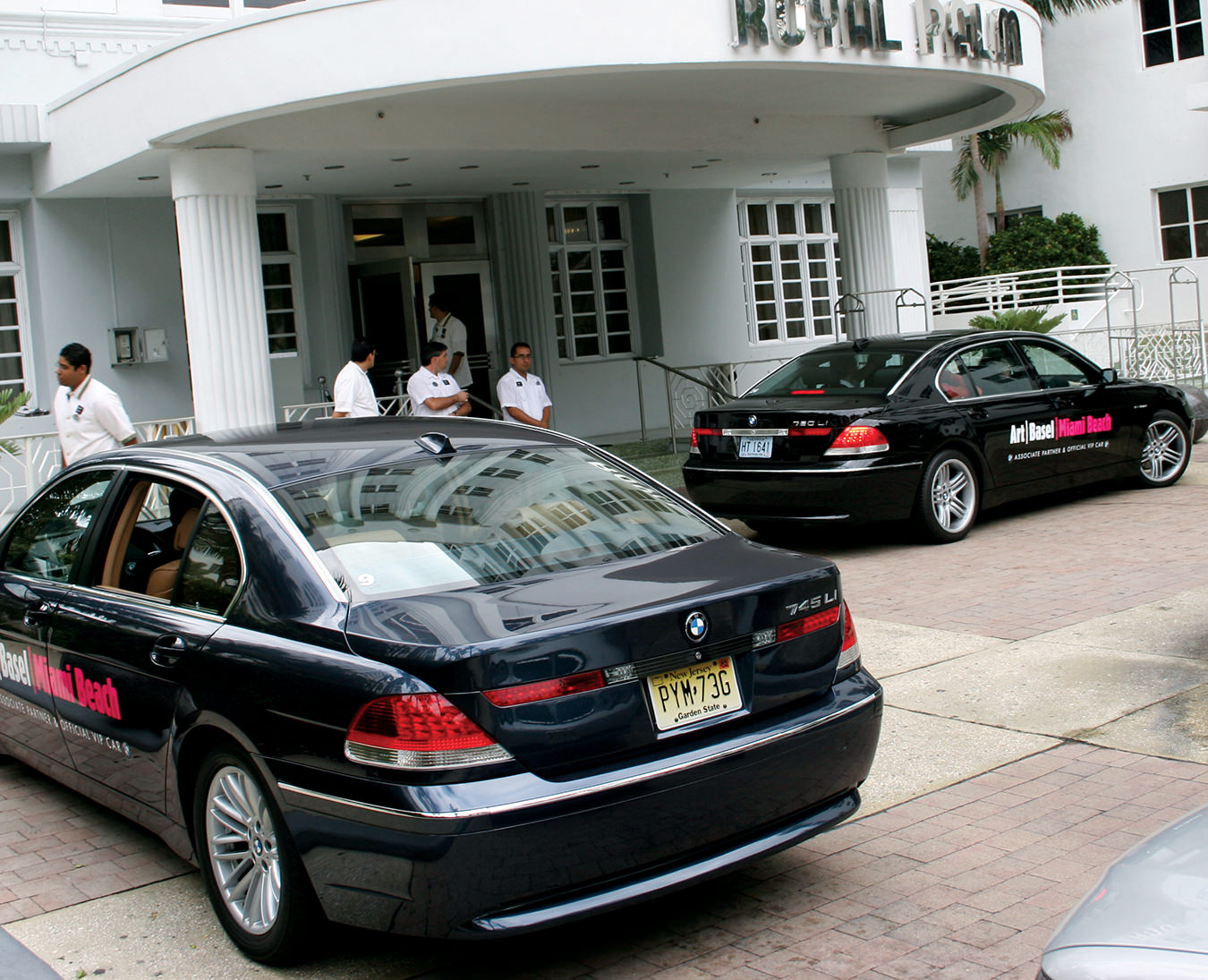
Cortège of 7-series BMWs at The Royal Palm.
-
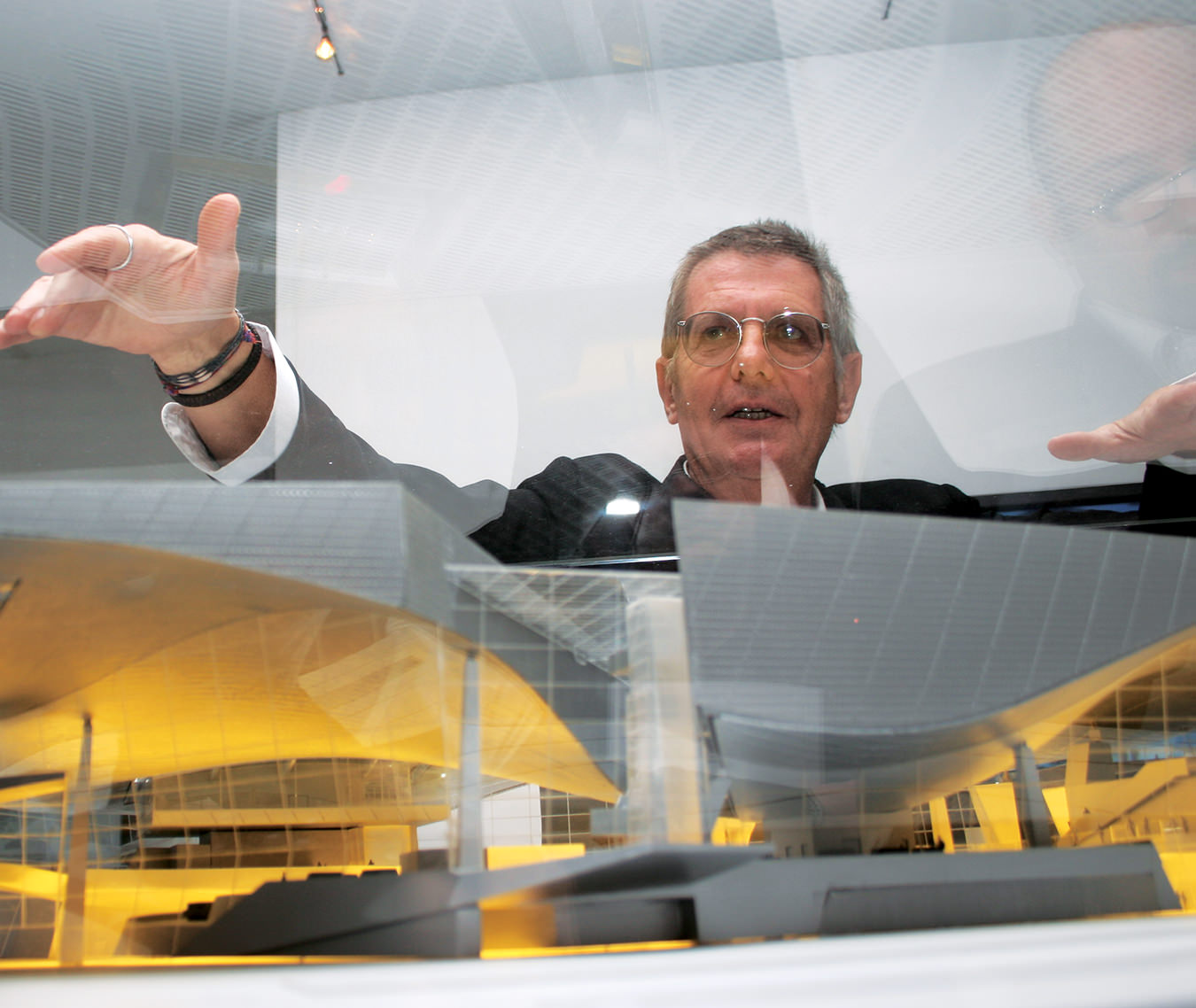
Prix model.
-

Rose de la Cruz in front of GI Wall.
Art Basel Miami Beach
Fine art in the new world.
On the first of December 2004, meteorologists announced the official end of Florida’s hurricane season. The same day, Samuel Keller, handsome guru of Art Basel Miami Beach (ABMB), ceremoniously declared the official launch of the “most important art fair in North America”. The tide was high, the moon was full, and the time was right. This four-day extravaganza opened with balmy breezes that reached a pleasantly hedonistic whirlwind before the week was out. The word on the street (in this case Miami’s south beach Collins Avenue, where gorgeous art deco hotels rolled out red carpets) was that Art Basel Miami Beach 2004 was not only out of the cradle, but reckoned to have hit full stride in just three years.
But how was this odd child-star of art fairs conceived? From what loins did the germ of this crazy inter-continental coupling spring? After all, Basel is a serene, medieval city on the River Rhine, tucked in the corner of Switzerland, between Germany and France. On the contrary, Miami Beach is a quintessential emblem of the United States of America, its sun-tanned, bikini-clad length stretched across the Bay of Biscayne, full frontal to the great Atlantic Ocean. Dating from 1882, when mangrove swamps were first cleared for a coconut plantation, it’s a mere 122 years old. Miami’s legal birth date is only 1915, when big daddy millionaire industrialists began building lavish winter Miami Beach homes, thus christened the Fifth Avenue of the South.
Those who have art collecting in their blood and their pocketbooks hold the answer to this cultural conundrum. Fact No.1, art fairs historically offer serious one-stop shopping, like the Biennale in Venice, the Armory in New York City, and Documenta in Kassel. Fact No.2, American art collectors are tending to prefer to spend their money within their country. Fact No.3, Miami is home to a rarefied breed that collects art, painting, drawing, sculpture, installation, print, photography, film, performance, and video and digital art, as though their very being depended on it. Fact No.4, the BMW Group, along with Bulgari, has stepped up to the plate for three consecutive years as an associate sponsor of ABMB, bringing to the party a European infusion of sensual design and architecture served with German and Swiss efficiency. Result, the city’s top planners, developers, architects, hoteliers, and art dealers have joined ranks to support Mr. Keller’s mission to maintain his top-ranking position in North America.
Yet it is the collectors themselves (not the dealers paying a minimum $50,000 USD for a coveted berth at this Queen Mary of art fairs) who lead the avant-garde of this social phenomenon. Record-breaking sales in four days ranged from $5,000 USD for emerging artists to museum-quality masterpieces with price tags in the millions of dollars. Even more amazing, at a time when privacy and security measures could not possibly be more heightened, the men and women of Miami Beach, envied more for their Lichtensteins and Rushas than their yachts and real estate, have opened the doors to their dens, kitchens, and, yes, their closets, to share their art with the world. A primer of a few of North America’s top collectors includes Irma and Norman Braman, Carlos and Rosa de la Cruz, Don and Mera Rubell, Craig Robbins, and Martin (Marty) Margulies.
Rosa de la Cruz and her husband came to the United States in 1960 as Cuban exiles. Carlos de la Cruz applied know-how and ingenuity to establish his hugely profitable Budweiser and Coca Cola bottling plants. But pure brilliance kicked in while chairing Miami’s United Way Fund: he enlisted star power by staging fundraisers at the Miami Beach homes of celebrities including actor Sylvester Stallone, Spanish crooner Julio Iglesias, Havana-born beauty Gloria Estefan, and the inimitable Madonna. And this, ladies and gentlemen, is the same star-power strategy ABMB employed to show the world that there are very, very important art collectors in Miami Beach.
For example, Rosa created a special installation for ABMB. Curated by Assume Vivid Astro Focus, the mezzanine above the kitchen was saturated with mildly psychedelic Big Sur wallpaper, and featured a wall section covered in General Idea’s AIDS (1989) silkscreen wallpaper, designed after Robert Indiana’s famous LOVE emblem. Rosa is particularly fond of Canada’s homegrown GI legacy “because their work expresses a generosity of spirit, and a desire to give back.”
Wandering freely through this world-renowned collector’s kitchen, bedroom and laundry room, as a total stranger, with no apparent security, felt quite perplexing. As if sensing this, Rosa pointed out a large billboard in her courtyard by an artist she considers the anchor of her collection, Jim Hodges.
“We live in an age now when we’re afraid; we’re always afraid. We travel, we’re afraid,” said Rosa. Hodges, living in New York City, invited delegates from member countries of the United Nations to write in their own handwriting and native language the phrase “Don’t be afraid”. Don’t Be Afraid has the familiar look of an autograph book filled with the best wishes of friends, but consists of 69 different shapes and sounds of three simple words that form at once a global command and a plea.
On that note, also unlocking their doors were Norman and Irma Braman, credited with having one of the most astonishing private collections in North America. And there it was, hanging from the living room ceiling (Alexander Calder), in the kitchen (Liza Lou, Andy Warhol, Tom Wesselman), the den (Joan Miro, Jean Arp, Claes Oldenberg, Jasper Johns), the dining room (Picasso, David Smith, George Segal, Calder), in the bedrooms (four Picassos and three Smiths), and the closets (Saul Steinberg, Segal). Other art in and around the expansive waterfront property included Willem de Kooning, Mark Rothko, Frank Stella, Robert Motherwell, Chuck Close, Clifford Still, and Louis Brougeois. No entrance fee, no uniformed security guards. Asked to comment on his 30 years of collecting, Braman said, “Well, like anything else, you always become known by the company you keep. It’s that way with art, especially with art.”
On the first of December 2004, Samuel Keller, handsome guru of ABMB, ceremoniously declared the official launch of the “most important art fair in North America”.
At the massive ABMB exhibition hall, configured with booths of varying sizes, representing over 1,500 artists of the 20th and 21st centuries. I visited the Corkin Shopland Gallery. “We’re here because Art Basel Miami Beach is now the most important art fair in North America,” said Martin Shopland, recently partnered with Toronto’s heavyweight dealer, Jane Corkin. Asked about their sales this year, Corkin said “This was a phenomenal year for sales, superceding last year. People are learning how to make decisions on the spot. But above all, as a dealer, you want to place your artists’ works into good collections, and appropriately, so that the collection becomes meaningful.”
In fact, Corkin has sat on the dealer selection committee since the first year of ABMB, which in 2004 comprised a dozen members from New York City, Milan, Wien, Berlin, Los Angeles, Barcelona and Sao Paulo. Experts in various fields of the profession, their tricky task is to decide who’s in and who’s not. In 2004, they eventually selected 190 galleries from 530 applicants. “It’s an extraordinary process, with very rigorous standards. This is a very serious business and, above all, the art is most important at the ABMB,” explained Corkin.
“You won’t see the same dealers or the same art here as in Switzerland,” said Shopland. “If you look around, there’s a lot more cutting edge contemporary art than you’re likely to see in Basel, which has been around for decades. Switzerland in June has quite a different flavour than Miami Beach in December.”
Augmenting this unique flavour, already saturated with the beat of sweet Brazilian samba and salty margaritas, was the omnipresence of 30 top of the line BMWs. It was fascinating to spot a cortège of 7 Series BMWs gliding out to Key Biscayne, or sifting along Ocean Avenue, chauffeuring their VIP charges from restaurants, to collectors’ homes, to museums, and to cocktails on the beach.
But BMW, whose 2004 worldwide auto sales exceeded expectations by 8.6 percent, was not in town to sell more cars. Michael Kirch, PR chief flown in from Munich, said, “ABMB is an important part of our ongoing strategic planning to initiate cultural involvement, for example our Art Car Collection.” To date, internationally renowned artists have painted 15 BMWs; the first was Alexander Calder in 1975, and the most recent was Jenny Holzer in 1999.
Thomas Girst, at the helm of BMW’s cultural communications, added, “We are also particularly proud that BMW had the foresight to commission renowned German artist Gerhard Richter to create three paintings for the lobby of our Munich headquarters.”
Richter’s 1975 abstract works are impressive panoramas, 10 by 20 feet, in the three primaries, red, blue, and yellow. The images are mercurially liquid and organic, as though the flow of air could be visible to the naked eye, perhaps what a BMW travelling at very high speeds might create.
BMW even invited the architect for Munich’s BMW Welt (World), slated to open in 2006. Professor Wolf Prix stood before his elegant scale model, built like a BMW, all shiny, reflective glass and silver outside, and graceful comfort inside. As excited as a kid at Disney World, he explained, “We have designed not just a factory, but a marketplace, exclusive delivery areas and a multi-purpose theatre for 600 people. At 14,000 square metres, this will be not only a BMW building, but a building for the people of Munich and visitors from around the world.”
A fascinating example of BMW’s highly successful product branding is their bmwfilms.com 2003 DVD release titled The Hire. It bundles eight short high-action films directed by top-shelf filmmakers, including John Frankenheimer, Ang Lee, Guy Ritchie, and John Woo. Starring in each is the new darling of British actors, the smoothly virile Clive Owen. But the real star in this clever ad campaign is BMW itself. In Woo’s The Hostage, for example, he opens with a camera close-up on one bullet being loaded into the empty barrel of a pistol. Spun roulette style, the image dissolves into a spinning hubcap, featuring the signature BMW blue and silver log, a visual double to an aircraft propeller, giving the nod to its namesake, the pioneering 1917 Bavarian Motor Works. Meanwhile, Owen, literally the knight in shining armor, at the wheel of his sexy BMW 24 Roadster, speaks to the kidnapper (the perp impeccably played by a sweaty, unshaven Maury Chaykin) over their cell phones, Nokia, of course designed by none other then the BMW Group’s California-based DesignworksUSA.
A tad tongue in cheek, the cautionary line is rolled at the end of each action-packed flick: “BMW recommends that you always wear your seat belt.” But on a very serious note, considering 2004 crowds numbered 33,000 from every continent, it would be entirely appropriate for Sam Keller and his Art Basel Miami Beach gang to extend exactly the same caveat to their guaranteed throngs of guests next year, as plans for ABMB 2005, December 1 to 4, are already in high gear.


